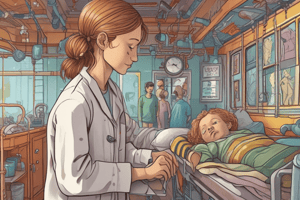Podcast
Questions and Answers
Which of the following is NOT a recommended intervention to prevent increased ICP?
Which of the following is NOT a recommended intervention to prevent increased ICP?
- Elevate the head of the bed (HOB)
- Encourage coughing (correct)
- Avoid holding breath during movement
- Do not restrain the patient
Fever and confusion are common signs of encephalitis.
Fever and confusion are common signs of encephalitis.
True (A)
What is the primary symptom that needs management in patients suspected of having meningitis?
What is the primary symptom that needs management in patients suspected of having meningitis?
Increased ICP
To prevent complications of immobility in patients, it is essential to monitor for __________ Syndrome.
To prevent complications of immobility in patients, it is essential to monitor for __________ Syndrome.
Match the following signs and symptoms with the correct condition:
Match the following signs and symptoms with the correct condition:
Which intervention is critical for patients at risk for seizures?
Which intervention is critical for patients at risk for seizures?
Pressure ulcers are not a concern for patients experiencing immobility.
Pressure ulcers are not a concern for patients experiencing immobility.
What muscle-related complications can arise from immobility?
What muscle-related complications can arise from immobility?
What is the purpose of a lumbar puncture?
What is the purpose of a lumbar puncture?
A positive Babinski reflex indicates normal motor function in adults.
A positive Babinski reflex indicates normal motor function in adults.
What should a patient do before undergoing a lumbar puncture?
What should a patient do before undergoing a lumbar puncture?
The procedure that assesses electrical activity of the brain is called _____
The procedure that assesses electrical activity of the brain is called _____
What is a common sign indicating meningitis when a patient's neck is flexed?
What is a common sign indicating meningitis when a patient's neck is flexed?
What does an electromyography (EMG) assess?
What does an electromyography (EMG) assess?
Match the following diagnostic tests with their primary purpose:
Match the following diagnostic tests with their primary purpose:
Seizures are a potential complication of meningitis.
Seizures are a potential complication of meningitis.
What procedure is performed to obtain cerebrospinal fluid (CSF) for lab analysis in suspected meningitis cases?
What procedure is performed to obtain cerebrospinal fluid (CSF) for lab analysis in suspected meningitis cases?
Why should a patient be asked about allergies before a CT scan?
Why should a patient be asked about allergies before a CT scan?
It is recommended for a patient to lie flat for a period after a lumbar puncture.
It is recommended for a patient to lie flat for a period after a lumbar puncture.
Meningitis can be caused by either __________ or bacteria.
Meningitis can be caused by either __________ or bacteria.
Which of the following is a treatment for bacterial meningitis?
Which of the following is a treatment for bacterial meningitis?
Match the following symptoms with their description in meningitis:
Match the following symptoms with their description in meningitis:
Isolation precautions should be taken for all viral meningitis cases.
Isolation precautions should be taken for all viral meningitis cases.
What is the name of the sign that indicates a positive reaction when extending the knee while hip is flexed?
What is the name of the sign that indicates a positive reaction when extending the knee while hip is flexed?
Flashcards are hidden until you start studying
Study Notes
Medical Treatment for Neurological Conditions
- Surgery is often combined with radiation therapy and may include chemotherapy as part of the treatment plan.
- Analgesics are administered for pain management.
- Monitor cognitive function and memory changes post-treatment.
Meningitis
- Inflammation of the meninges can be caused by viruses or bacteria.
- Bacterial organisms may enter through blood, head wounds, or nearby cranial structures (sinuses, inner ear).
- Potential complications: seizures, septicemia, vasomotor collapse, increased intracranial pressure (ICP).
Diagnosis and Symptoms of Meningitis
- Lumbar puncture used to collect cerebrospinal fluid (CSF) for lab analysis.
- Common signs: headache, nuchal rigidity (stiff neck), irritability, reduced consciousness, photophobia, seizures.
- Positive Kernig sign: pain upon straightening the knee after hip flexion indicates meningeal irritation.
- Positive Brudzinski sign: involuntary hip flexion upon neck flexion suggests meningeal irritation.
Treatment for Meningitis
- Bacterial: antimicrobial therapy is critical.
- Viral: focus on symptom management.
- Anticonvulsants prescribed for seizure control.
- Isolation precautions may be necessary for infection control.
Interventions for Increased ICP
- Monitor and prevent increased ICP: avoid coughing, elevate head of bed (HOB), and avoid breath-holding during movement.
- Ensure respiratory status is assessed regularly.
- Pain management and seizure precautions are essential.
- Monitor for complications of immobility, including respiratory issues, pressure ulcers, and muscle weakness.
Encephalitis
- Inflammation of brain tissue primarily caused by viral infections.
- Symptoms include fever, nuchal rigidity, headache, confusion, and potential alterations in motor activity.
- Management includes seizure precautions and symptom relief.
Guillain-Barré Syndrome
- A neurological condition that requires monitoring and interventions similar to those for meningitis and encephalitis.
Neurological Assessments
- Evaluate pupils for size, shape, and reactivity to assess neurological function.
- Observation of neuromuscular responses helps evaluate cerebral and spinal cord status.
Diagnostic Testing
- Lumbar Puncture: used for assessing CSF pressure, requires informed consent and preparation, and resting post-procedure is crucial.
- Electroencephalography (EEG): assesses brain electrical activity.
- Electromyography (EMG): evaluates peripheral nervous system responses.
- Radiological studies, including CT scans, are used for detecting trauma, tumors, and hemorrhage.
- Assess for allergies prior to CT scans due to potential reactions to contrast agents.
Reflex Testing
- Babinski reflex: abnormal response indicates motor pathway issues; negative (normal) is downward toe curling, while positive is upward curling of the big toe and fanning of others.
Studying That Suits You
Use AI to generate personalized quizzes and flashcards to suit your learning preferences.




